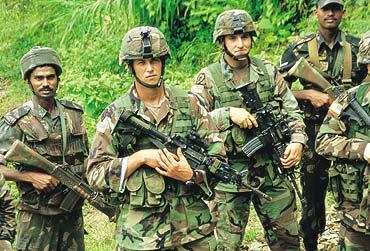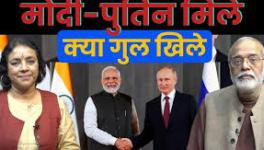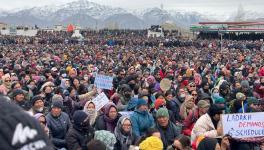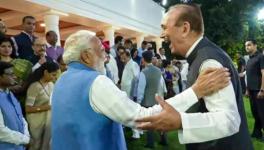‘Military diplomacy’ sounds like an oxymoron. Diplomacy is about culture and finesse –graduated gratification of desire- military is about roughing it out and instant success.
|
|
| Photo Courtesy: OutlookIndia.com |
‘Military diplomacy’ sounds like an oxymoron. Diplomacy is about culture and finesse –graduated gratification of desire- military is about roughing it out and instant success. However, the phrase ‘military diplomacy’ is as frequently used as ‘cultural diplomacy’. While the latter “conjures up images of ambassadorial dinner parties and the elite pastimes of the Fererro Rocher set,”[1] the former is more about gunboats.
The two are often hyphenated because, diplomacy is as much about pressurization, as it is about persuasion. And more often than not, coercive military power either precedes or follows foreign policy.
It is perhaps to avoid the use of an oxymoron that a high powered working group at the Institute for Defence Studies and Analyses (IDSA), New Delhi has titled their recent report as, “Deliberations on Military and Diplomacy.”[2]
Besides catering to “restructuring the Ministry of Defence (MoD)... to ensure greater integration of the civilian bureaucracy with the Armed Forces Headquarters” - the IDSA document, is also guided by pragmatic imperatives to use ‘defence cooperation’ and Indian “military professionalism, including the high standards of its military training institutions and capacities in the field of international peacekeeping ...in furtherance of its foreign policy objectives.”
The aim to integrate military into the national decision making process is laudable. However, what needs a more rigorous debate is the effort to conjoin the civil-military reform with foreign policy imperatives – re-orienting the Indian military from a force guarding the nation to a resource to be exploited to secure a place on the high table of “international security politics”.
Simply put, the proposed reforms are less inclined towards self–correcting the existing anomaly in the national higher defence management and more to satiate the American demands to have well trained military manpower at its disposal in Asia.[3]
The US financial resources and security ambitions are precariously perched on a fiscal cliff.[4] United States has enough fighter planes and satellites to soften any land on earth, what it does not have is the unlimited quantity of boots on ground to actually go and occupy the conquered land. As Robert Kaplan says in his latest book, “anyone who truly believes that geography has been pivotally downgraded is truly ignorant of military logistics - of the science of getting significant quantity of men and materiel from one continent to another.”[5]
Since Washington does not have the money to ensure mobility of its troops across continents, it is urging New Delhi to contribute its soil and soldiers to sustain the falling empire. And many, with a fetish to see India as a vassal state with ‘great power’ tag have no hesitation to suggest using India’s ‘demographic dividend’ to please pentagon.
The IDSA document uses terms like “benign security provider “and ‘defence cooperation’ to add academic flavour to the American demands. In sharp contrast, Lt Gen (Retd) Satish Nambiar, in his article placed as an annexure to main document, openly admits that time is ripe for India to follow Henry Kissinger’s prescription and “behave like the British Raj” and share America’s security burden in the Indian Ocean Region. In order, to support his case for making the Indian armed forces expeditionary, Nambiar, goes to the extent of citing historical examples from World War I and II, where millions of Indian men were used as cannon fodder to save and expand the British Empire. One hopes that the general is his eagerness to send Indian troops on “out of area missions” is not hinting at rechristening the Indian army as American–Indian Army.
The Indian military leadership has always been a step ahead of the bureaucracy in courting Pentagon. This fact came up when Wikileak exposed a 2009 US Embassy cable addressed to Hillary Clinton that blamed India's civilian leadership and bureaucracy for adding road blocks to the fruition of Indo-US strategic partnership – “slowing down a relationship that the military brass was keen to accelerate.” [6] A point reiterated in the latest report by S. Amer Latif, of Centre for Strategic and International Studies, report on Indo-US relations, where he elucidates,
“Although the Indian military is keen for a much closer relationship with its U.S. counterparts, the MOD bureaucracy is consistently in the background, keeping the services on a tight leash. The reluctance for closer ties has stymied deeper strategic discussions between the U.S. and Indian. armed forces, and has also caused frustrations on the U.S. side about last-minute cancellations of exercises, courses, or visits. The MOD’s reluctance has also led to strict prohibitions on social contact between active-duty U.S. and Indian officers outside official business. Such restrictions stymie the development of personal relationships, which could be helpful in times of crisis.” [7]
More interesting is Latif’s highlight on Indian military’s recommendation to boost up the Indo-US ties, which sadly rely on seeking foreign appointments for Indian military leaders in PACOM and Central Command and also executive level courses at the Asia-Pacific Center for Strategic Studies or the Near East South Asia Center for Strategic Studies.[8]
The Indian military has little experience of swimming in the international political pool. Therefore, their concerns largely revolve around protecting their corporate interests, based on seeking foreign tenures and well advertised American military equipment. International politics is a dirty game. Recent revelations, on Falkland War have thrown adequate light on how the CIA, instigated the, Junta in Argentina to invade Falkland Island, and simultaneously, provided tacit support to Britain to win the war.
The well-designed war elevated Margret Thatcher to the status of ‘iron lady’ giving her the required energy to push forward Regan’s privatization agenda in UK. On the other hand, poor General Galtieri, after losing the war was pushed into a corner in Buenos Aries. According to former CIA boss, William Casey, Argentinian General had “wrongly believed its (his) support for US covert operations in Central America would mean Washington's 'acquiescence' for the 1982 invasion.”[9]
Why look as far as Argentina - Pakistan military’s more than six decade old relationship with Pentagon offers a good example of how the armed forces that are mortgaged to the empire can wreck havoc for their own nation. The idea of strategic tie-up with US is fraught with great dangers of making our military an entity that can become bigger than the state. We need to reform our civil-military conundrum, but that cannot happen in the backdrop of US imperial demands. India is not so bankrupt that it needs to put the lives of its young men on the negotiating table to sustain their relevance in the US scheme of things. India cannot be Pentagon’s Back Office to make itself a great power. [10]
[1]The Art of diplomacy, BBC News, 28 February, 2007
http://news.bbc.co.uk/2/hi/uk_news/magazine/6403643.stm
Also see, Mark Lamster, “The Art of Diplomacy”, The Wall Street Journal, , 10 October 2009.http://online.wsj.com/article/SB10001424052748703298004574459753201012282.html
[2] “Deliberations of a Working Group on Military and Diplomacy”, Institute for Defence Studies and Analyses(IDSA), New Delhi, January 2013, http://www.idsa.in/system/files/book_MilitaryDiplomacy.pdf
[3]Net Security Provider: India’s Out-of-Area Contingency Operations, IDSA Task Force Report, Magnum Publishers, 2012.
[4]“Sustaining U.S. Global Leadership: Priorities for 21st Century Defense”, Department of Defence, USA, January 2012, http://www.defense.gov/news/defense_strategic_guidance.pdf
[5] Robert D. Kaplan, The Revenge of Geography , eBook, location 697, 2013
[6] Siddharth Varadarajan, “U.S. cables show grand calculations underlying 2005 defence framework”, The Hindu, March 28, 2011
[7] S. Amer Latif, U.S.-India Military Engagement - steady as they go, A report of the Center for Strategic & International Studies, US, December 2012, http://csis.org/publication/us-india-military-engagement
[8] Ibid.
[9] Brendan Carlin, “US may have accidentally helped to start Falklands war by encouraging Argentinians to invade islands, admits ex-CIA chief”, Mail Online, 30 December 2012, http://www.dailymail.co.uk/news/article-2254755/US-accidentally-helped-start-Falklands-war-encouraging-Argentinians-invade-island-admits-ex-CIA-chief.html#ixzz2HTj1ffNA
[10] Atul Bharadwaj, India as Pentagon’s back office?, The Indian Express, 25 June 2003, http://teleradproviders.com/nbn/editorialstory.php?id=MTAwOQ%3D%3D
Disclaimer: The views expressed here are the author's personal views, and do not represent the views of Newsclick

























